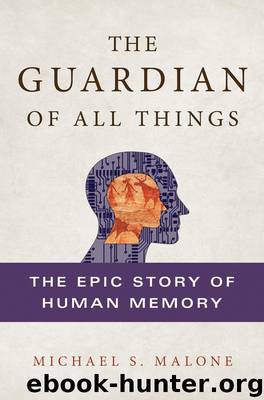The Guardian of All Things by Michael S. Malone

Author:Michael S. Malone
Language: eng
Format: epub
Publisher: St. Martin's Press
OUT OF MIND
The zeal for classification during the High Middle Ages and early Renaissance didn’t just infect scholars, occultists, and ecclesiastics but also the first modern scientists. Speaking across the ages, the recovered Aristotle had called upon all scientists to look beyond what ought to be true to what really was true—that is, to observe the natural world.
The protoscientists of the Middle Ages, such as Roger Bacon and al-Haythem, took this process one step further from the pure deduction of Aristotelian science to the much more ambitious induction of the scientific method—a process codified by Francis Bacon and enshrined in institutions such as the Royal Society of London, the Academie Française, the Italian Accademia, and the German Academy—all founded in the seventeenth century and all dedicated to systematizing and improving scientific research.
The result was not only an exciting new era of scientific discovery but, behind all of those great discoveries, mountains of observational data and volumes of lesser discoveries. As these caches of information grew they posed their own problems, slowing new research and inhibiting dissemination. Needless to say, the field was ripe for organization—in particular, for classification schemes that not only put all of this knowledge in its place, free of superstition and prejudice, but also added to the overall understanding.
The names of the scientists who first took on the challenge of compiling, organizing, and classifying the accumulated knowledge in their disciplines are often honored today as the “pioneers” of their fields. Among the first were the physician Andreas Vesalius with his groundbreaking work (1543) on human anatomy and the physicist William Gilbert on electricity and magnetism (1600). Later classifiers included Carl Linnaeus, the father of modern taxonomy (1735) and the man whose Systema Naturae gave a Latin designation to all species, living and extinct; Boyle and Lavoisier on chemistry; Dalton on atomic theory; Mendeleev with the periodic table of elements; Newton on classical mechanics; Charles Lyell on geology; and Alexander von Humboldt on geography. Even the pictorial works of John James Audubon are part of this tradition.
By the end of the eighteenth century, almost every scientific discipline had been given structure, oversight, and a system of classification. And these seminal scientific works—along with the encyclopedias, the natural histories, and ethnology picture books; the atlases, dictionaries, and biographies; the compiled speeches and national and military histories—had in their own unexpected way managed to accomplish what Bruno, Camillo, and even Cicero had failed to do: They had put all of human memory within reach of the average person, no matter what that person’s natural aptitude.
The Art of Memory had struggled to find a biological solution to the challenge of retaining massive amounts of memory inside the human brain. Its solution was to define a new kind of information retention, and come up with extremely complicated tools to supercharge it.
The High Middle Ages and the Renaissance, venerating the ancients, at first tried to revive the lost memory arts. But in the end, and facing a far greater memory challenge, it found instead a technological solution: printed books.
Download
This site does not store any files on its server. We only index and link to content provided by other sites. Please contact the content providers to delete copyright contents if any and email us, we'll remove relevant links or contents immediately.
Enlightenment Now: The Case for Reason, Science, Humanism, and Progress by Steven Pinker(7273)
A Journey Through Charms and Defence Against the Dark Arts (Harry Potter: A Journey Through…) by Pottermore Publishing(4789)
The Immortal Life of Henrietta Lacks by Rebecca Skloot(4550)
A Journey Through Divination and Astronomy by Publishing Pottermore(4363)
Elon Musk by Ashlee Vance(4084)
Origin Story: A Big History of Everything by David Christian(3666)
COSMOS by Carl Sagan(3589)
Alchemy and Alchemists by C. J. S. Thompson(3481)
Bad Pharma by Ben Goldacre(3396)
Enlightenment Now by Steven Pinker(3349)
Shadow of Night by Deborah Harkness(3326)
Inferior by Angela Saini(3293)
A Mind For Numbers: How to Excel at Math and Science (Even If You Flunked Algebra) by Barbara Oakley(3256)
Origin Story by David Christian(3170)
The Code Book by Simon Singh(3138)
Signature in the Cell: DNA and the Evidence for Intelligent Design by Stephen C. Meyer(3098)
The Elements by Theodore Gray(3026)
A Brief History of Time by Stephen Hawking(2992)
A Journey Through Potions and Herbology (A Journey Through…) by Pottermore Publishing(2837)
